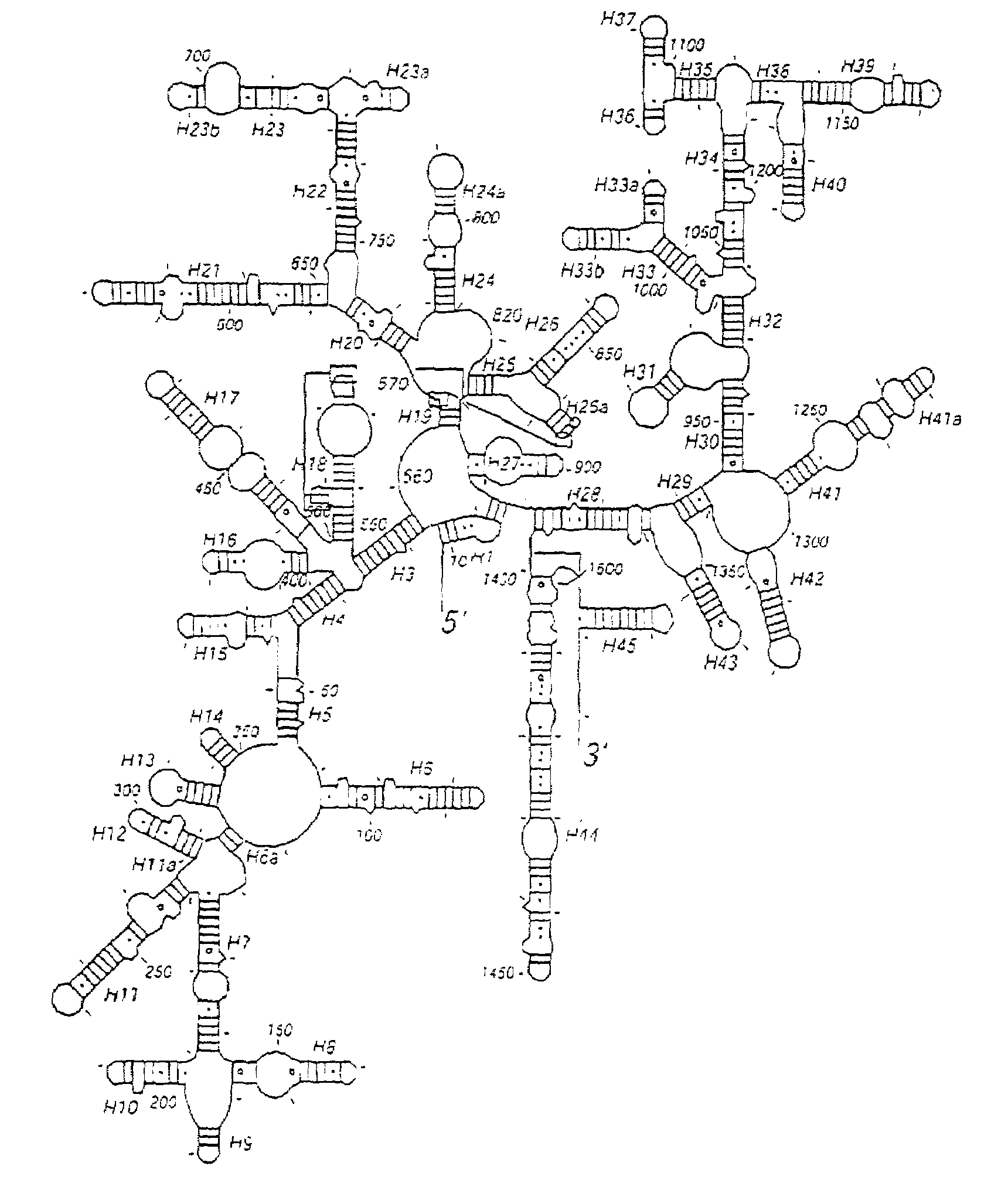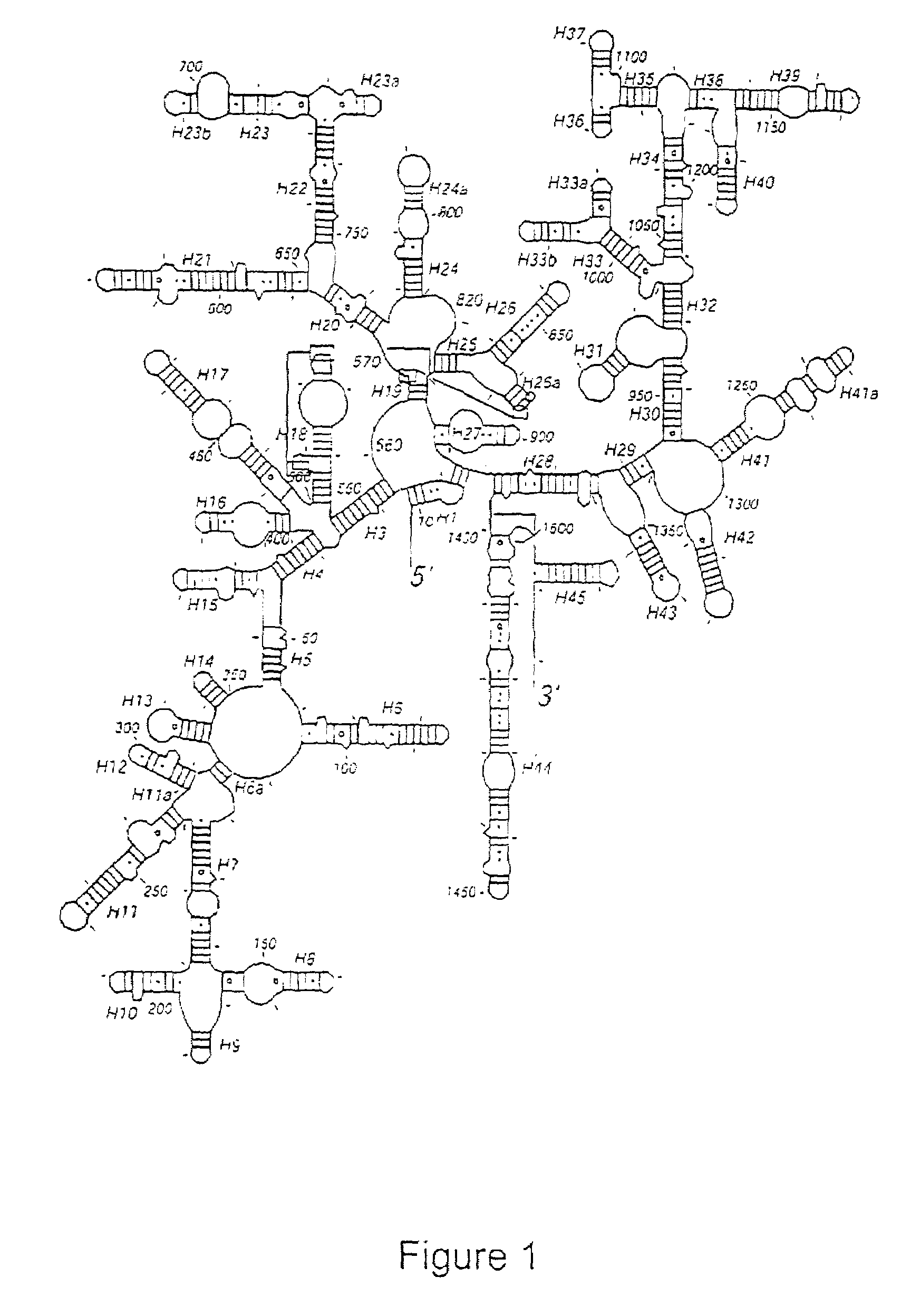Crystal structure of the 30S ribosome and its use
a crystal structure and 30s technology, applied in the field of can solve the problems of low resolution of the crystal structure of the prokaryotic 30s ribosome subunit, resistance to current antibiotics is currently a major problem, and few new antibiotics are available, so as to achieve the effect of higher resolution
- Summary
- Abstract
- Description
- Claims
- Application Information
AI Technical Summary
Benefits of technology
Problems solved by technology
Method used
Image
Examples
example 1
Crystallization of the 30S Ribosomal Subunit
[0244]Crystals of T. thermophilis 30S ribosomal subunits were obtained by an optimization of the procedure reported by Trakhanov et al. (Trakhanov, S. D. et al FEBS Lett. 220, 319±322 (1987)) with respect to pH and concentrations of Mg2+ ions and 2-methyl-2,4-pentanediol (MPD) as described in Wimberly et al. Nature 407, 327-339 (2000). The final conditions were 250 mM KCl, 75 mM NH4Cl, 25 mM MgCl2 and 6 mM 2-mercaptoethanol in 0.1 M potassium caco-dylate or 0.1 M MES (2-N-morpholino-ethanesulphonic acid) at pH 6.5 with 13±17% MPD as the precipitant. 30S crystals completely lacked ribosomal protein S1. Selective removal of the S1 subunit prior to crystallization improved both the crystal size and reproducibility in crystal growth. Typical procedures used to remove the S1 subunit include the use of poly-U sepharose chromatography followed by extensive salt washing as described by Subramanianet et al. Eur. J. Biochem. 119, 245-249 and Subrama...
example 2
Computer Based Method of Rational Drug Design
[0245]This example provides a computer-based method of rational drug design. To obtain structural information about the protein / drug interaction to allow rational drug design, it is first necessary to prepare a crystal of the complex, the complex being the drug bound to the 30S ribosomal subunit. A crystal of the complex can be produced using two different methods. In a first method, the actual complex itself is crystallized using the prescribed conditions set forth for the native 30S ribosomal subunit. Once crystals of a suitable size have grown, X-ray diffraction data are collected and analyzed as described by Greer et al., J. of Medicinal Chemistry, Vol. 37, (1994), 1035-1054. This process usually involves the measurement of many tens of thousands of diffracted X-rays over a period of one to several days depending on the crystal form and the resolution of the data required. According to the method, crystals are bombarded with X-rays. T...
example 3
An Example of a Computer Based Method for Identifying a Potential Inhibitor of the 30S Ribosome
[0246]This example discloses a computer based method to identify a potential inhibitor of the 30S ribosome. The structure of an antibiotic bound to the 30S defines “crystallographically known sites.” A number of molecular docking procedures can be used to design novel binders that also bind to these sites. For example, the programs MCSS and Ludi can be used to dock small fragments that can then be linked together to form a novel ligand. Molecular docking procedures, as used herein, refer to the use of computer programs, as defined herein, to identify potential ligands that are predicted to stably interact with a defined site on the 30S ribosome subunit. Alternatively, libraries of compounds as described herein are converted into 3D format using programs such as Concord (Tripos), CeriusII (Accelrys) etc. The 3D structures of the ligands are then docked against a site on the ribosome. This s...
PUM
| Property | Measurement | Unit |
|---|---|---|
| wavelengths | aaaaa | aaaaa |
| pH | aaaaa | aaaaa |
| pH | aaaaa | aaaaa |
Abstract
Description
Claims
Application Information
 Login to View More
Login to View More - R&D
- Intellectual Property
- Life Sciences
- Materials
- Tech Scout
- Unparalleled Data Quality
- Higher Quality Content
- 60% Fewer Hallucinations
Browse by: Latest US Patents, China's latest patents, Technical Efficacy Thesaurus, Application Domain, Technology Topic, Popular Technical Reports.
© 2025 PatSnap. All rights reserved.Legal|Privacy policy|Modern Slavery Act Transparency Statement|Sitemap|About US| Contact US: help@patsnap.com



